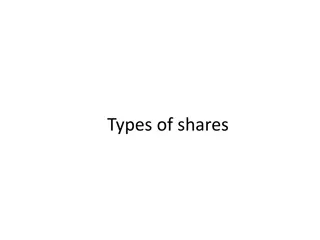Comparison of Preference Shares and Equity Shares in Company Finance
Preference shares offer priority in dividend payments and capital repayment, fixed dividend rates, and no voting rights, while equity shares have lower face value, variable dividend rates, and participation in surplus profits. The differences lie in control over management, arrears of dividend, redeemability, voting rights, and investor preferences. Deferred shares have high dividend rates but postponed payments and are not commonly used in public companies.
Uploaded on Oct 03, 2024 | 0 Views
Download Presentation

Please find below an Image/Link to download the presentation.
The content on the website is provided AS IS for your information and personal use only. It may not be sold, licensed, or shared on other websites without obtaining consent from the author. Download presentation by click this link. If you encounter any issues during the download, it is possible that the publisher has removed the file from their server.
E N D
Presentation Transcript
PREFERENCE SHARES: Preference shares are shares which have preferential rights in respect of payment of dividend and repayment of share capital in the event of the winding up to the company.
FEATURES OF PREFERENCE SHARES: First priority of payment of dividend. Fixed rate of dividend. First priority of repayment of capital. No voting right. Less risk. Arrears of dividend.
DIFFERENCE BETWEEN PREFERENCE SHARES AND EQUITY SHARES. Preference shares Equity shares 1. Face value of share is high. Face value is low 2. Preferential right in the payment of dividend and repayment of capital at the time of winding up of the company. No preferential right. 3. Rate of dividend remains fixed from year to year Rate of dividends varies year to year depending upon the amount of profits available for distribution. 4. The rate of dividend generally fixed by the articles of association. Rate of dividend on equity shares is dependent on the discretion of the Board of Director 5. No surplus profit at the time of winding up of the company Equity shares can participate in the surplus profit and surplus assets.
6.Preference share can get arrears of dividend (except those preference share holder) Equity shares cannot get the arrears of dividend. 7. Preference shares can be redeemable during the existence of the company Equity shares are not redeemable during the life of the company. 8. No voting right (limited voting right ) Have voting right. 9. It is considered as rentier capital It is considered as risk capital. 10. It is preferred by cautious investors It is preferred by adventurous investors. 11. The holder of preference shares do not have much control over the management of the company The holders of equity shares have much control over the management of the company. 12. Not considered as real owner of the company. Equity share holders are the real owners of the company.
13. Amount of capital raised by the preference shares is generally less Amount of capital raised by the equity shares are generally high. 14. It provides both long term and medium term capital. It provides only long term capital. 15. Market value of the shares remains more or less stable. Market value of the shares fluctuate greatly from year to year.
DEFERRED SHARES: Deferred shares whose right to receive dividend is deferred or postponed to the end. Features: High rate of dividend. Payment postponed. Small nominal value Disproportionate voting right Not attractive to the general public. Companies cannot have deferred shares. But, private company can issue

























